Title: The Annals of the Four Masters
Full Title: The Annals of the Four Masters – Irish history, kingship and society in the early seventeenth century
Author: Bernadette Cunningham
Publisher: Four Courts Press
Published: 2014
ISBN: 9781846825385
Pages: 348 including Appendix, Bibliography and Index.
Synopsis: Continue reading…
Category Archives: Celtic Scholar’s Reviews and Opinions
FLED BRICRENN The Feast of Bricriu
I seem to have underestimated the number of little green books that I have so here are two more wonderful additions. As usual I will not be reviewing them in depth but I will talk about structure and the most interesting parts in them.
As you must have read from the title of the post the books I will be taking about today are related to the Feast of Bricriu. And there are two books for this post: Fled Bricrend (The Feast of Bricriu) and Fled Bricrenn: Reassessments.
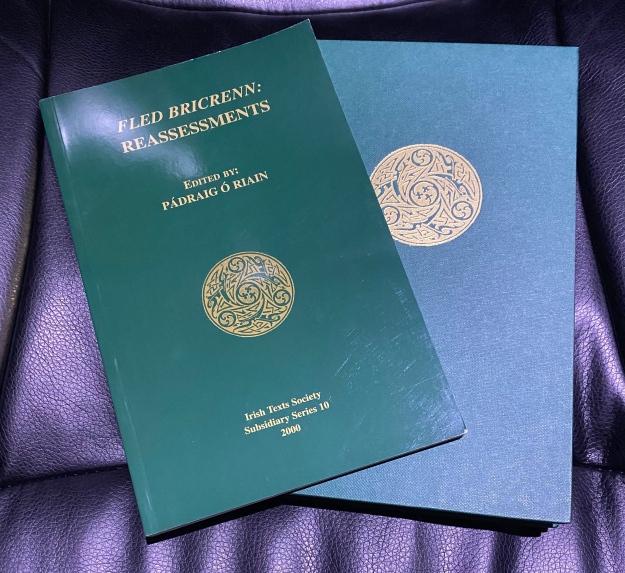
Buile Suibhne
This review is not going to be about content but about what is available on this story in the Irish Text Society. I said a while back that I had finished all my Little Green Books but apparently I didn’t.
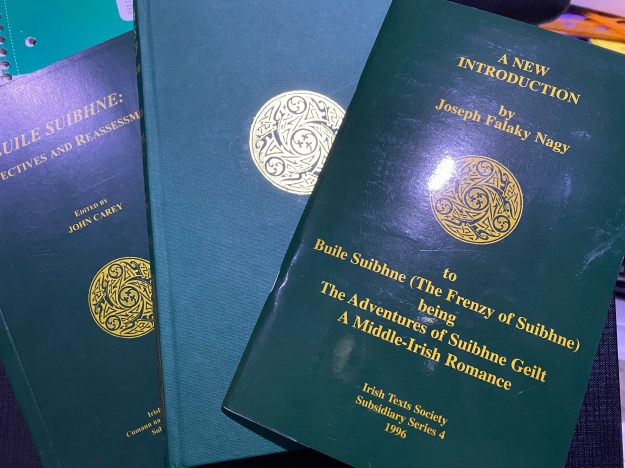
Book One: A New Introduction by Joseph Falaky Nagy.
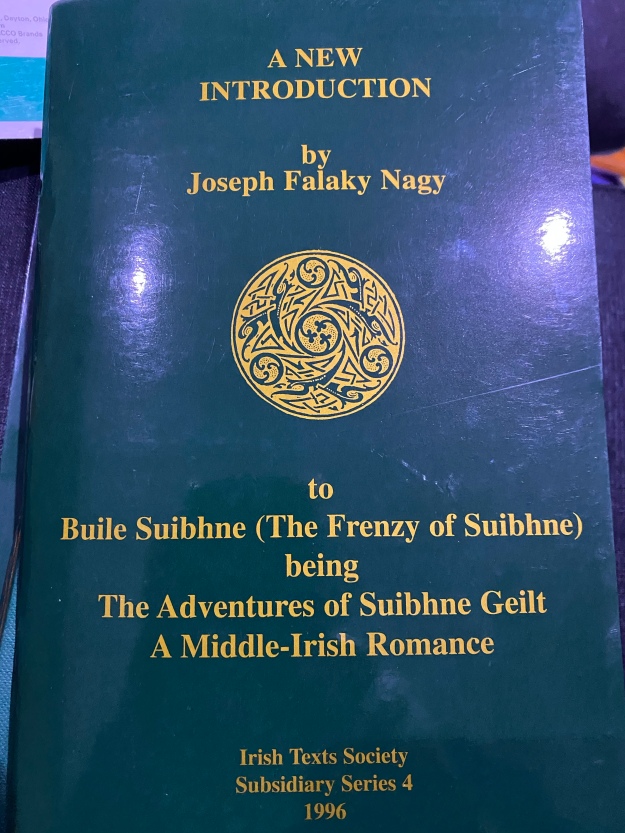
I read this Introduction two times, once before reading the main book and once after reading the main book. The first time I will admit that I didn’t really understand everything in the Introduction but after reading the main book it became very clear. Just a heads up if you have this book no need to read the first 32 pages of the main book as they are the same.
Main Book: Buile Suibne

This is the 1996 edition which has the same Introduction as the book above on top of the 1913 Introduction to the text. The Introduction, translation notes, and glossary of the original were all done by J. G. Keefe.
The original Introduction begins after page 32 and has a summary of the story, the manuscripts used, the dates of the manuscripts, a summary of the Battle of Magh Rath. Suibhne Geilt, the origins of the tale, and finally the composition of the tale.
The first chapter is the tale itself with the left side being the Irish and the right side being the English translation. The tale and translation end on page 159 (Not including the 32 pages of the Nagy Introduction). The notes start on page 161 and end on page 173. There is also a glossary that starts on page 179. The Index starts on page 193.
Book Three: Buile Suibhne – Perspectives and Reassessments
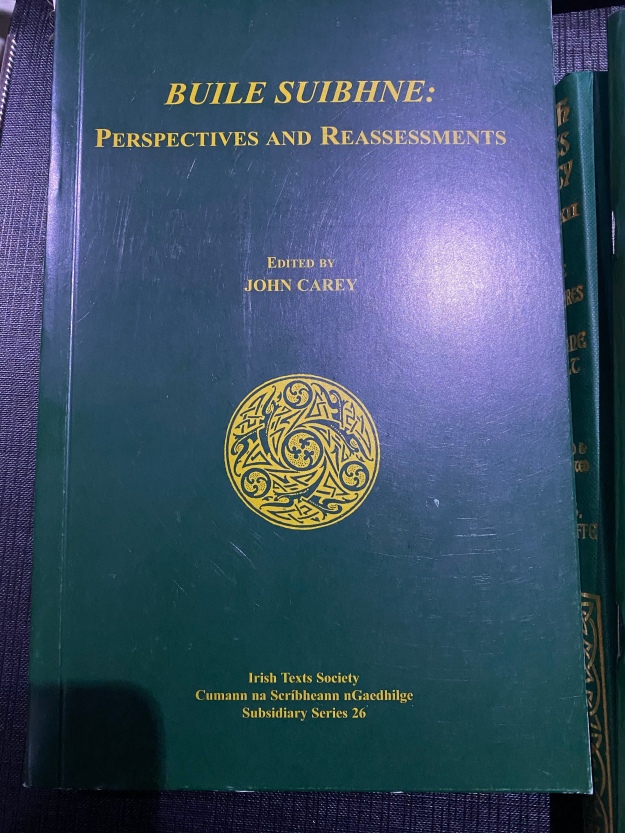
This is the text that I found most interesting. The 6 essays included in the volume all have interesting hypotheses and re-appraisals of scholarship related to the text.
The essays are:
- The Cult of St. Moling and the Making of Buile Shuibne by Máirín Ní Dhonnchadha.
- The “Death of the Wild-Man” in the Legend of Suibhne Geilt by Brian Frykenberg
- The Authorship and Transmission of Buile Shuibne a Re-Appraisal by Alexandra Bergholm
- James George O’Keeffe 1865-1937 by Pádraigín Riggs
- At Swim-Two-Birds: Sweeny and Many Others by Breandán Ó Conaire
- A Study of the Irish Legend of the Wild Man by Pádraig Ó Riain
My favorite ones are the first and the last essays. They have good analysis and interesting hypotheses.
The three books read together or if you have the 1996 or 2011 versions of the main book then just the main book and the assessments, are a great edition to the library of any Irish Literature buff and anyone who wants to understand the tale of the Frenzy of Suibhne.
Standish O’Grady’s Cuculain and Other Books
*This is a review of one book but along side reading this book I also read 3 others that are related to it. Those books are:
- History of Ireland: The Heroic Period
- History of Ireland: Cuculain and his Contemporaries
- History of Ireland: Critical and Philosophical
Now back to the main book.
Full Title: Standish O’Grady’s Culculain: A Critical Edition
Synopsis: Between 1878 and 1881, Standish O’Grady published a three-volume History of Ireland that simultaneously recounted the heroic ancient past of the Irish people and helped to usher in a new era of cultural revival and political upheaval. At the heart of this history was the figure of Cuculain, the great mythic hero who would inspire a generation of writers and revolutionaries, from W. B. Yeats and Lady Augusta Gregory to Patrick Pearse. Despite the profound influence O’Grady’s writings had on literary and political culture in Ireland, they are not as well known as they should be, particularly in view of the increasingly global interest in Irish culture. This critical edition of the Cuculain legend offers a concise, abridged version of the central story in History of Ireland-the rise of the young warrior, his famous exploits in the Tain Bo Cualinge (The Cattle Raid of Cooley), and his heroic death. Castle and Bixby’s edition also includes a scholarly introduction, biography, timeline, glossary, editorial notes, and critical essays, demonstrating the significance of O’Grady’s writing for the continued reimagining of Ireland’s past, present, and future. Inviting a new generation of readers to encounter this work, the volume provides the tools necessary to appreciate both O’Grady’s enduring importance as a writer and Cuculain’s continuing resonance as a cultural icon.
Review: Continue reading…
Book Review Kings and Warriors
Full Title: Kings and Warriors in Early North-West Europe
Editors: Jan Erik Rekdal and Charles Doherty
Publisher: Four Courts Press
Published: 2016
ISBN: 978-1-84682-501-9
Pages: 480 including bibliography and index, the bibliography starts on page 433
Synopsis: This book explores the representation of the warrior in relation to the king in early north-west Europe. These essays, by scholars from the areas of Norse, Celtic and Anglo-Saxon studies, examine how medieval writers highlighted the role of the warrior in relation to kings, or to authority, and to society as a whole. The warrior who fought for his people was also a danger to them. How was such a destructive force to be controlled? The Christian church sought to challenge the ethos of the pagan tribal warrior and to reduce the barbarism of warfare (at least its worst excesses). We can follow this struggle in the medieval literature produced in the areas under study.
Review: Continue reading…
The Destruction of Da Derga’s Hostel
Full Title: Destruction of Da Derga’s Hostel: Kingship and Narrative Artistry in a Mediaeval Irish Saga
Author: Ralph O’Connor
Synopsis: Irish saga literature represents the largest collection of vernacular narrative in existence from the early Middle Ages, using the tools of Christian literacy to retell myths and legends about the pagan past. Continue reading…
CATH MAIGE MUCRAMA
Full title: Cath Maige Mucrama – The Battle of Mag Mucrama (Volume # 50)
Pages: 157 pages, includes Introduction, Appendix, Notes, Index to Notes, Names of Persons, Names of Peoples, and Names of Places.
As usual with these books I’m not going to review the content of the myth rather I’m going to comment on the Introduction and the way the book is put together. The Introduction starts by telling the reader that none of the texts that will appear in the book is appearing for the first time. … Continue reading…
Book Review OIDHEADH CHLOINNE HUISNEACH
Full Title: Oidheadh Chloinne hUisneach (The Violent Death of Uisneach
Edited and Translated by: Caoimhín Mac Giolla Léith
Published by: Irish Texts Society
Review: The book has 9 chapters which the editor calls sections. In the Introduction (Section 1) the editor says that the book aims to provide a critical edition of the Early Modern Irish prose tale Oidheadh Chloinne hUisneach. … Continue reading…
BOOK REVIEW: 2 books
BOOK 1: Lebor Na Cert (The Book of Right)
Series: Volume XLVI
BOOK 2: Lebor Na Cert Reassessment
Series: Subsidiary Series No. 25
Review: There is no way I’m going to review The Book of Right of course but I will be discussing some points about it. Continue reading…
BOOK REVIEW Language and Tradition in Ireland
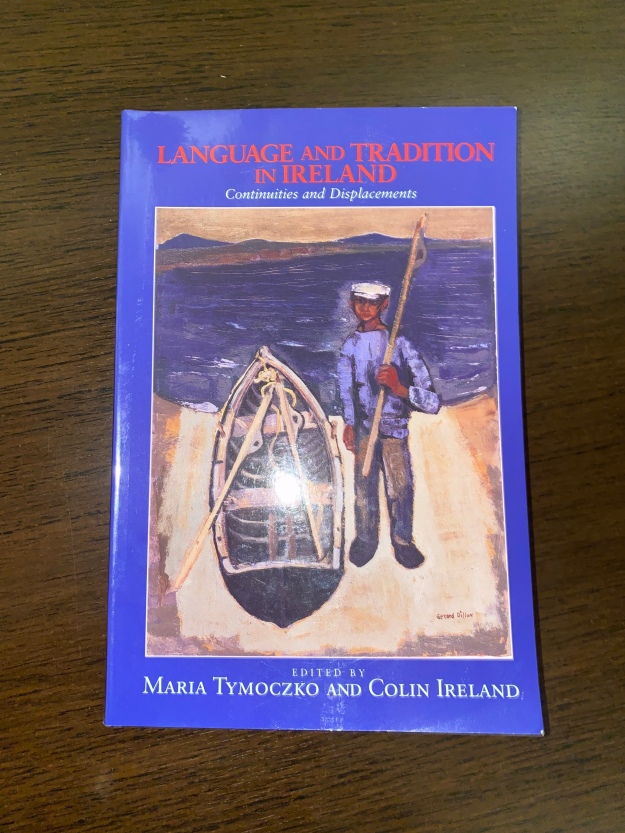
Full Title: Language and Tradition in Ireland: Continuities and Displacements
Synopsis: If language and culture are intimately connected, then cultures involving people who speak more than one language must have special characteristics, as well as particular social issues to negotiate. What are the challenges faced by a people with two or more languages as their heritage? How does that multiple heritage affect cultural forms, including literature and the arts? How does linguistic difference influence the conceptualization and writing of history? And if the meeting of languages within a people has involved contestation and power, how are those conflicts negotiated?